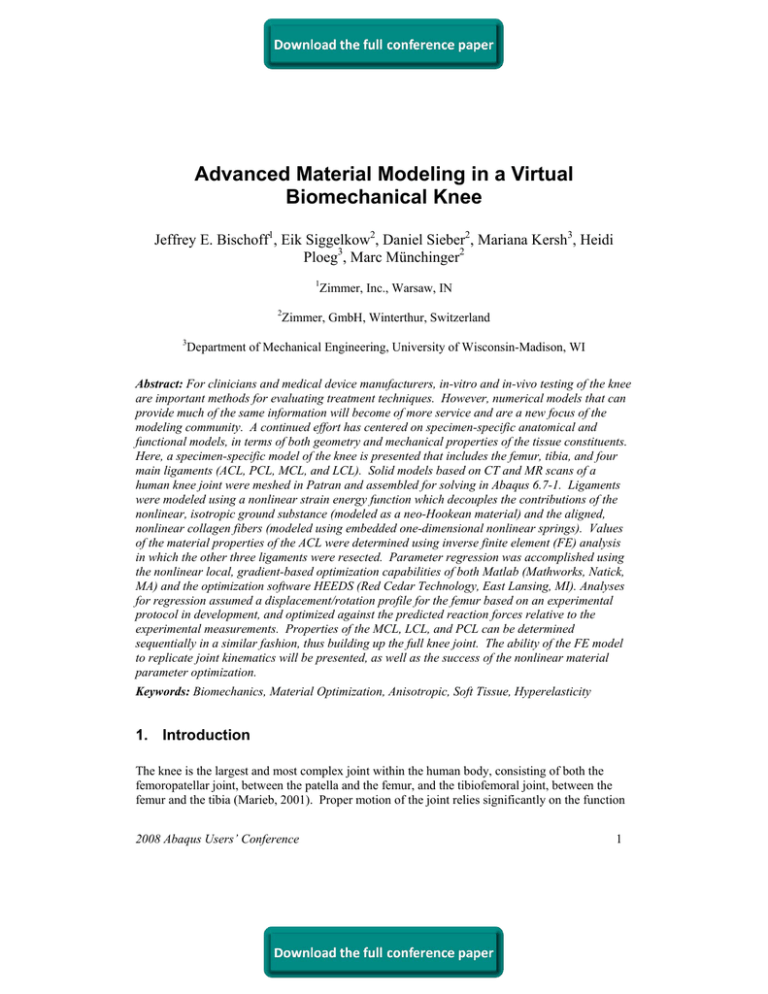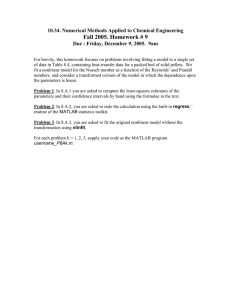Advanced Material Modeling in a Virtual Biomechanical Knee Jeffrey E. Bischoff
advertisement

Advanced Material Modeling in a Virtual Biomechanical Knee Jeffrey E. Bischoff1, Eik Siggelkow2, Daniel Sieber2, Mariana Kersh3, Heidi Ploeg3, Marc Münchinger2 1 Zimmer, Inc., Warsaw, IN 2 Zimmer, GmbH, Winterthur, Switzerland 3 Department of Mechanical Engineering, University of Wisconsin-Madison, WI Abstract: For clinicians and medical device manufacturers, in-vitro and in-vivo testing of the knee are important methods for evaluating treatment techniques. However, numerical models that can provide much of the same information will become of more service and are a new focus of the modeling community. A continued effort has centered on specimen-specific anatomical and functional models, in terms of both geometry and mechanical properties of the tissue constituents. Here, a specimen-specific model of the knee is presented that includes the femur, tibia, and four main ligaments (ACL, PCL, MCL, and LCL). Solid models based on CT and MR scans of a human knee joint were meshed in Patran and assembled for solving in Abaqus 6.7-1. Ligaments were modeled using a nonlinear strain energy function which decouples the contributions of the nonlinear, isotropic ground substance (modeled as a neo-Hookean material) and the aligned, nonlinear collagen fibers (modeled using embedded one-dimensional nonlinear springs). Values of the material properties of the ACL were determined using inverse finite element (FE) analysis in which the other three ligaments were resected. Parameter regression was accomplished using the nonlinear local, gradient-based optimization capabilities of both Matlab (Mathworks, Natick, MA) and the optimization software HEEDS (Red Cedar Technology, East Lansing, MI). Analyses for regression assumed a displacement/rotation profile for the femur based on an experimental protocol in development, and optimized against the predicted reaction forces relative to the experimental measurements. Properties of the MCL, LCL, and PCL can be determined sequentially in a similar fashion, thus building up the full knee joint. The ability of the FE model to replicate joint kinematics will be presented, as well as the success of the nonlinear material parameter optimization. Keywords: Biomechanics, Material Optimization, Anisotropic, Soft Tissue, Hyperelasticity 1. Introduction The knee is the largest and most complex joint within the human body, consisting of both the femoropatellar joint, between the patella and the femur, and the tibiofemoral joint, between the femur and the tibia (Marieb, 2001). Proper motion of the joint relies significantly on the function 2008 Abaqus Users’ Conference 1






